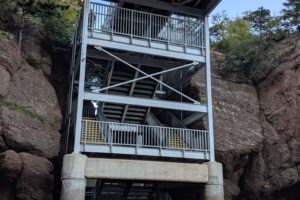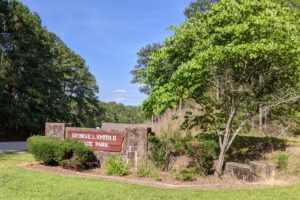As we’ve mentioned earlier, history follows geology, which eventually means rivers. In the northwest corner of ND where the Missouri and Yellowstone Rivers meet, trade happened early with those living and coming here (the previous post has more about this trading). The big word for this post is confluence, where the 2 rivers come together.




This gift makes the land and the water available to the public and safeguards it against development so that the land remains much like how Lewis and Clark viewed it in 1805—without the cottonwood trees.

Cottonwoods are common along the streams and rivers of ND. They are the largest tree native to the state and the fastest growing. Various Native American tribes used this tree for making yellow dye from the young leaf buds and eating the inner bark of the young sprouts. Their children used the leaves and other parts of the tree to make their toys. Walking along the trails by the confluence, “you can hear these lovely sounds [of the constant rustle of leaves, even on a still day] and possibly see the tree’s cotton seeds drifting in the breeze.”
In Lewis’ journal, he also described the area as almost an idyllic paradise in scenery and wildlife.

Clark and the main group of the expedition were stopped from joining Lewis by high winds early in the afternoon. Eventually that day they were able to join up. Clark’s group traveled a total of 14.25 river miles to meet up with Lewis and his group.
After becoming one group again, the men were given such jobs as exploring the Yellowstone River as far as a man could go in 1 day, collecting buffalo meat that they had dried the previous day, hunting for more meat, and reaching the actual confluence. When Clark measured the width of both rivers, he found the Missouri to be 520 yards wide and the Yellowstone to be 858 yards wide.
what happened hundreds of years ago?


These items have been found in North Dakota, proving that the land wasn’t always as we know it today.



right: These freshwater clams fossils are about 60 million years and clearly show the shells from that time.


The skull in the previous picture with me shows what the actual skull would have looked like 47,000 years old.






rivers for trading


Early traders would have used canoes and other small boats to navigate the rivers. But as trade increased, the need also increased for transporting larger amounts of furs and supplies.

This steamer and others hauled passengers, cargo, military supplies, and annuity goods between Bismarck, ND, and Fort Benton in Montana. I’m not exactly sure what annuity goods were, but from what I could read, they were goods the Army promised to send on a regular basis to support those living along the Missouri in western states and territories.


Captain Marsh piloted his boat back safely to Bismarck, ND, a distance of around 900 miles in just 54 hours—an achievement unrivaled in the history of Missouri River navigation.
navigating the Missouri
Only twice a year is the Missouri River easy to navigate because the water levels are high enough: in April because of the local snow melt, and in June because the the Rocky Mountain snow melt. The configuration of the boats themselves allowed them to make good time even when the rise came late or not at all.

1900 – 1920s navigation
Smaller, more economical riverboats began appearing on ND rivers late in the 19th century. These newer boats were both steamboats and gasoline-powered motor vessels (sometimes called Gas Packets).
Isaac Baker built Benton Packet Company in 1901 (Washburn, ND) where new equipment made loading and unloading easier from boats and barges. His boats became the model for upper Missouri boatmen. Eventually he was able to expand upriver to the confluence where Block P boats hauled whatever freight and agricultural products were offered.
Block P boats? I couldn’t find anything about them, but boats can be put up on blocks for storage or repair. So I’m thinking that Block P boats are boats on wheels or supports so items can be transported to their final destination.

Fort Union – 1829 to 1867
Fort Union was the “queen” of the American Fur Company’s Upper Missouri locations. Built near the confluence of 2 major rivers, it was ideally located for trading with Indians on the northern Plains. We looked at this fur trading fort in the previous post.


This tribe, along with Arikara, Plains Cree, and Sioux of the northern Plains; the Crow of the Upper Yellowstone; and Blackfeet in central Montana all supplied furs to the international fur trade industry through Fort Union. In return, they received such American and European goods as guns, knives, glass beads, cookware, and dinnerware.
The arrival of the horse and gun had a profound impact on Native People. The horse came from the southwest, and the gun arrived from the north by way of native and European traders. The horse and the gun transformed hunting and warfare, giving a distinct advantage to the tribes that had both.

Horses meant the Native People could travel farther to find food, increasing their chances of successful hunts. More food also meant an increase in population. More buffalo hides meant tipis could be bigger. More horses also meant they could travel further when it was time for the tribe to move since they no longer had to depend on dogs to pull the travois (a dog sled) that held each family’s belongings.

General Sully surveyed the land in this area on his return from his 1864 campaign against the Sioux in western Dakota Territory and decided on a 4-square mile reservation close to Fort Union. Fort Buford was constructed within this surveyed area; in 1868, the reservation was extended to 30 miles square.
Fort Buford – 1866 to 1895
When the fur trade declined, Fort Union went out of business and was eventually sold to the U.S. Army. The buildings were dismantled, and the timber was used to build Fort Buford just 4 miles away.




In its last days, the fort sprawled across the river bottoms. Long piles of cord wood in this picture was going to be used for the barracks, officers’ quarters, commanding officer’s quarters, housing for NCO families, sawmill, hospital, and the surgeon’s quarters. The last expansion was completed by 1872. The fort at its height had about 100 buildings and was large enough land-wise to deter attacks; it did not have a stockade around it because the immense amount of land around it provided a natural barrier that Indians would have had to cross to get to the fort itself. We saw the layout of Fort Buford in the previous post.
moving around on the Prairie

In 1832, the American Fur Company’s steamboat Yellowstone chugged its way up the Missouri (top of previous picture), ushering in a new era of moving goods quickly between St. Louis, Fort Union, and beyond. The early steamboats were fueled by wood that was often cut by company employees. Later the wood was purchased from independent contractors known as wood-hawks [entrepreneurs always a niche].
By the 1870s, western rivers steamboats, particularly those on the Missouri, had developed into powerful, shallow-draft boats pushed by stern-wheels.

If you’d like to know more about what the steamboats carried to the gold fields as they navigated the Missouri River, you can go to our post about the paddle wheel Bertrand that ran aground between Nebraska and Iowa in 1865. It’s in our 2018 California family visit, part 4.

For more information about this boundary dispute, see part 16 and part 17 of this ND trip.



This multipurpose light vehicle was pulled by 4 horses or mules to transport equipment during campaign duty. When fitted with removable seats, it could be used as a troop carrier.

Since this museum had so much to see, we’ll finish looking at its exhibits in the next post.




